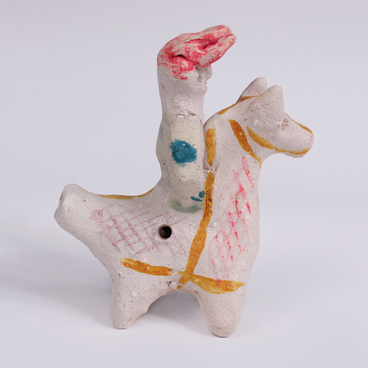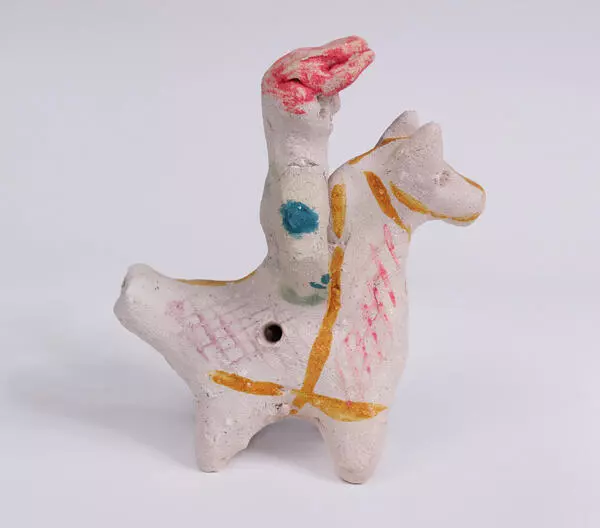This rooster clay toy was created by a craftswoman Olga Deriglazova. She was born in 1912 in the village of Kozhlya. She became one of the three artists who preserved the Kozhlya clay toymaking along with Ulyana Kovkina and Valentina Kovkina.
There are even special styles based on the names of these craftswomen. The researcher Tatyana Skoblikova says that today the Kozhlya clay toys are divided into two types: Deriglazovsky and Kovkinsky. The first is considered more traditional, while the second is more minimalistic. In her toys, Olga Deriglazova used ‘broken’ lines. At the same time, her images are funny, emotional, and even fabulous. Her sister Ulyana Kovkina worked in a similar manner.
As for Valentina Kovkina, her lines were precise and brought to full completion. Thus, her images were clear and created no confusion.
At the same time, both styles have a common basis. For example, craftswomen had the same sequence of modeling the toys of the ‘animal’ type. First, they rolled a ball, which then was flattened into a pancake. Then it was wrapped around a special preform for the toy’s body (the so-called “dumpling” or “pie”). After that, they caulked the seam and formed a whistling part. Then they used additional lumps of clay to attach a head, legs, ears, and other elements.
Researchers also mentioned the most important tool of toymakers called “shpichka” — a stick for making incisions in whistles. It was made of spindle wood, which was considered particularly strong and resilient. The craftswomen searched for thick and straight stems without knots. They were cut into sticks and dried, “Dry spindle wood was splintered, cleaned and chopped with a knife so that they were slightly curved — round and sharp at one end and flat like a spattle at the other. Then the sticks were dipped into boiling water to soften the wood and then the surface was scrubbed with glass until it was perfectly smooth.” One end of the stick was left flat and thin to make two main whistling holes. The other end was sharpened and round to create side incisions, as well as eyes, mouths, and noses. The flat end was put in the flame of a match to prevent them from breaking. Masters always kept a whole set of shpichkas of various widths and lengths for different toys.
There are even special styles based on the names of these craftswomen. The researcher Tatyana Skoblikova says that today the Kozhlya clay toys are divided into two types: Deriglazovsky and Kovkinsky. The first is considered more traditional, while the second is more minimalistic. In her toys, Olga Deriglazova used ‘broken’ lines. At the same time, her images are funny, emotional, and even fabulous. Her sister Ulyana Kovkina worked in a similar manner.
As for Valentina Kovkina, her lines were precise and brought to full completion. Thus, her images were clear and created no confusion.
At the same time, both styles have a common basis. For example, craftswomen had the same sequence of modeling the toys of the ‘animal’ type. First, they rolled a ball, which then was flattened into a pancake. Then it was wrapped around a special preform for the toy’s body (the so-called “dumpling” or “pie”). After that, they caulked the seam and formed a whistling part. Then they used additional lumps of clay to attach a head, legs, ears, and other elements.
Researchers also mentioned the most important tool of toymakers called “shpichka” — a stick for making incisions in whistles. It was made of spindle wood, which was considered particularly strong and resilient. The craftswomen searched for thick and straight stems without knots. They were cut into sticks and dried, “Dry spindle wood was splintered, cleaned and chopped with a knife so that they were slightly curved — round and sharp at one end and flat like a spattle at the other. Then the sticks were dipped into boiling water to soften the wood and then the surface was scrubbed with glass until it was perfectly smooth.” One end of the stick was left flat and thin to make two main whistling holes. The other end was sharpened and round to create side incisions, as well as eyes, mouths, and noses. The flat end was put in the flame of a match to prevent them from breaking. Masters always kept a whole set of shpichkas of various widths and lengths for different toys.



